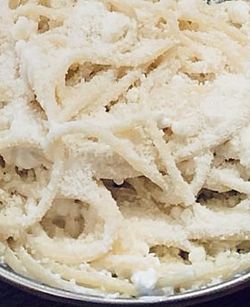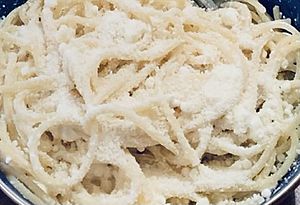Lokshen mit kaese facts for kids

Lokshen mit kaese (לאָקשן Lokshyn mit kaese)
|
|
| Alternative names | Lokshen with cheese, lokshen with cottage cheese, Jewish egg noodles with cottage cheese, Jewish mac and cheese, itriyot v’gvina, lokshyn mit kaese, lockshen noodles with cheese |
|---|---|
| Type | Cheese noodles |
| Course | Main |
| Place of origin | Jewish from Eastern Europe. Today mostly in Israel, the United States, France, Canada, United Kingdom, Australia, Argentina, South Africa, and other communities in the Jewish diaspora. |
| Created by | Ashkenazi Jews |
| Serving temperature | Warm |
| Main ingredients | Lokshen noodles, cottage cheese or farmers cheese, salt, black pepper, less commonly butter, cream cheese, parmesan cheese, sour cream, cinnamon sugar, caramelized onions |
| Variations | Lokshen kugel |
Lokshen mit kaese (say "LOK-shen mit KAY-zeh") is a yummy Jewish dish. It's also called "Jewish mac and cheese" or "lokshen with cheese." This meal is made with special Jewish egg noodles called lokshen. These noodles are mixed with a creamy cheese sauce. The sauce usually has cottage cheese and black pepper. Sometimes, other cheeses like farmer's cheese are used. People might add sour cream, butter, or even caramelized onions.
You can also find a sweet version! This one is often topped with cinnamon sugar. Many people think of Lokshen mit kaese as a comforting Jewish food. It's a bit like a noodle kugel, but in a simpler, "deconstructed" way. This dish is very popular among Ashkenazi Jews, especially in places like the United States.
What's in a Name?
The name Lokshen mit kaese comes from the Yiddish language. In Yiddish, it means "lokshen (Jewish egg noodles) with cheese." It's a very direct name for a simple, delicious dish!
A Look at Its History
Lokshen mit kaese has a long history, going back over 800 years! It started in the Jewish communities of Eastern Europe during the Middle Ages. Back then, it was a cheap and filling meal for families.
"For generations before me, Jews across Central and Eastern Europe shared my devotion to starch and cream, serving egg noodles mixed with pot cheese as a quick, satisfying meal. Like many weeknight dishes, the recipe for lokshen mit kaese, as it is called in Yiddish, was budget-friendly, alluringly homey, and effortless. As Arthur Schwartz writes in his book Jewish Home Cooking: Yiddish Recipes Revisited, it is a dish you cook “when you think there’s nothing in the house to eat.” Seasoned in the Litvak manner with a copious sprinkle of salt and pepper, as Schwartz enjoys it, or dusted with sugar in the Galitzianer tradition, noodles and pot cheese is Jewish comfort food par excellence." — Leah Koenig
Different Jewish communities had their own ways of making it. For example, Lithuanian Jews liked a savory version. They added lots of salt and pepper. But Polish Jews preferred a sweet version. They would sprinkle it with sugar and sometimes cinnamon.
When Jewish people moved from Eastern Europe to places like the United States and Israel, they brought this dish with them. It stayed popular in the American Jewish community for a long time. However, in the late 1900s, some people started to eat it less. This was partly because of new ideas about healthy eating.
Today, Lokshen mit kaese is still a beloved comfort food. It's often compared to macaroni and cheese. Many American Jews have even added new ingredients to it. These include Italian pasta, butter, parmesan cheese, mint, and cherry tomatoes.
How It's Made

There are two main ways to make Lokshen mit kaese: savory or sweet. Both versions usually start with lokshen noodles, cottage cheese, and sour cream. Sometimes butter is added too.
- The savory version often includes salt, pepper, and caramelized onions.
- The sweet version is topped with cinnamon and sugar. This is similar to how a sweet noodle kugel is made.
Some people get creative with their recipes! For example, a chef named Melissa Clark makes a version with mint, cherry tomatoes, scallions, and dried currants.
"My mom actually managed to [cook when I was growing up], which was amazing because she was the primary breadwinner. She was a big muckety muck in the nursing world, and she eventually ran a school of nursing out of the St. Barnabas hospital in Livingston. So she had kind of kooky hours, but she still managed to be the mom who came home and cooked dinner. She was actually a very good cook. A lot of it was not traditional Jewish food, but on holidays certainly the Passover plate was the Passover Plate, and Hanukkah was latkes, and flanken was very big in our house. She made a dish, I can’t remember what she called it, but it was bowtie egg noodles with pot cheese, much moister than the buckwheat. That was one of our favorites. She was a terrific cook. I say was, she’s still alive at 93." — Jason Alexander
To prepare the dish, you first boil the lokshen noodles. Traditionally, people used longer, homemade egg noodles. But today, many use store-bought lokshen or even bowtie pasta. Sometimes, other Italian pasta shapes like macaroni elbows are used too.
Once the noodles are cooked al dente (meaning they're firm but not hard), they are mixed with cottage cheese. Other ingredients like butter, cream cheese, parmesan cheese, or garlic might be added. A good amount of black pepper is usually included. Some people even serve it with ketchup!
In Popular Culture
- Lokshen mit kaese is sometimes used as a Yiddish slang phrase. It means "everything is easy" or "everything is hunky dory."
- The dish was mentioned in a song in a 2013 Broadway play. The play was called When You're in Love the Whole World is Jewish. Actor Jason Alexander, who was in the play, has said that Lokshen mit kaese was one of his favorite foods growing up.

